Comprehensive Report on TESCO's Strategy, Enterprise, and Innovation
VerifiedAdded on 2023/06/17
|10
|2689
|291
Report
AI Summary
This report provides a strategic analysis of TESCO, a multinational grocery and merchandise retailer, focusing on its internal resources, capabilities, and external environment. It utilizes SWOT and VRIO frameworks to assess TESCO's strengths, weaknesses, opportunities, and threats, along with its valuable, rare, imitable, and organizational resources. The report also employs PESTLE analysis to understand the political, economic, social, technological, legal, and environmental factors impacting TESCO's operations and entrepreneurial activities. Furthermore, Porter's Five Forces model is used to evaluate the competitive forces within the retail industry, including the threat of new entrants, substitutes, buyer power, and supplier power, to determine TESCO's competitive advantage and potential strategies for growth and development. The analysis highlights the importance of understanding both internal and external factors for strategic decision-making and sustainable business practices.
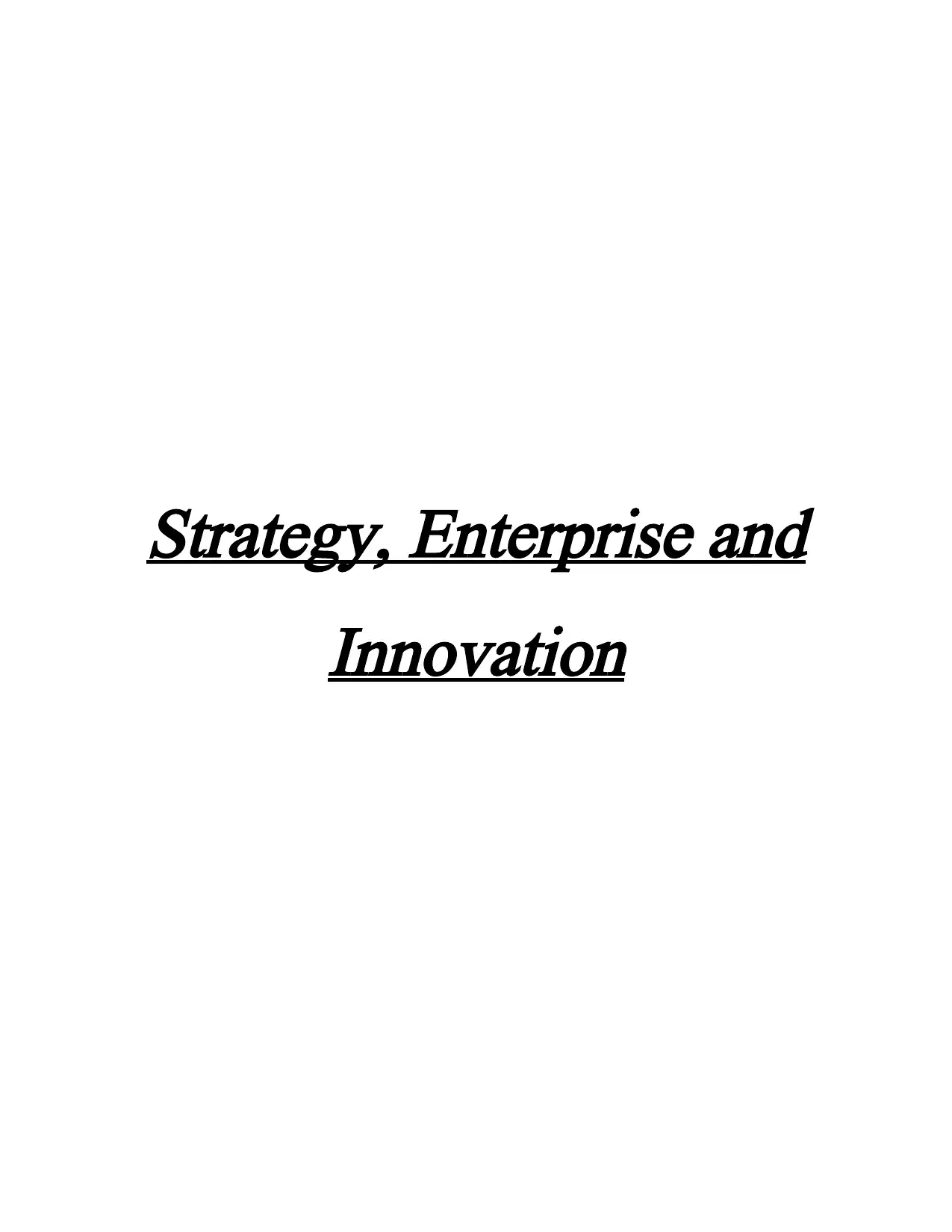
Strategy, Enterprise and
Innovation
Innovation
Paraphrase This Document
Need a fresh take? Get an instant paraphrase of this document with our AI Paraphraser
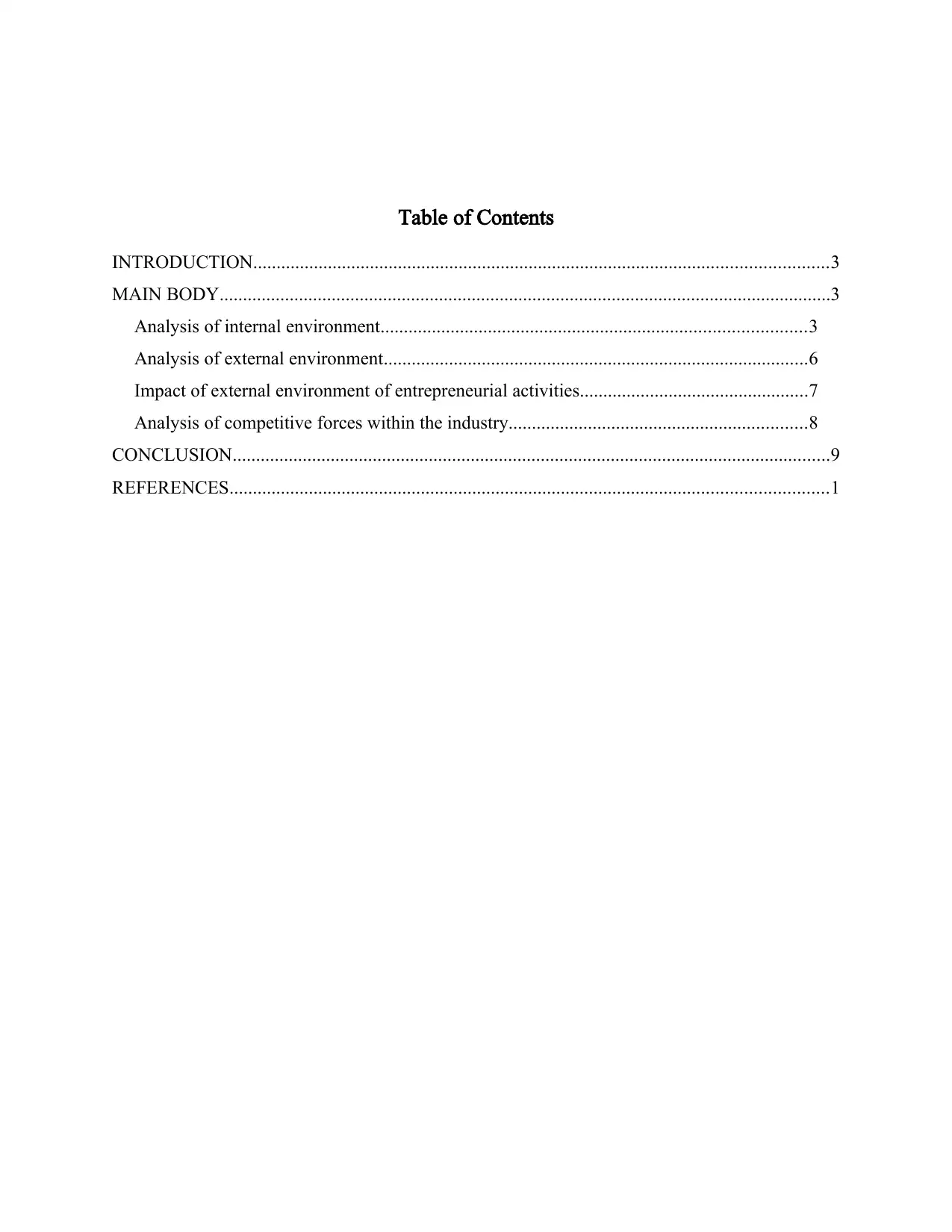
Table of Contents
INTRODUCTION...........................................................................................................................3
MAIN BODY...................................................................................................................................3
Analysis of internal environment...........................................................................................3
Analysis of external environment...........................................................................................6
Impact of external environment of entrepreneurial activities.................................................7
Analysis of competitive forces within the industry................................................................8
CONCLUSION................................................................................................................................9
REFERENCES................................................................................................................................1
INTRODUCTION...........................................................................................................................3
MAIN BODY...................................................................................................................................3
Analysis of internal environment...........................................................................................3
Analysis of external environment...........................................................................................6
Impact of external environment of entrepreneurial activities.................................................7
Analysis of competitive forces within the industry................................................................8
CONCLUSION................................................................................................................................9
REFERENCES................................................................................................................................1
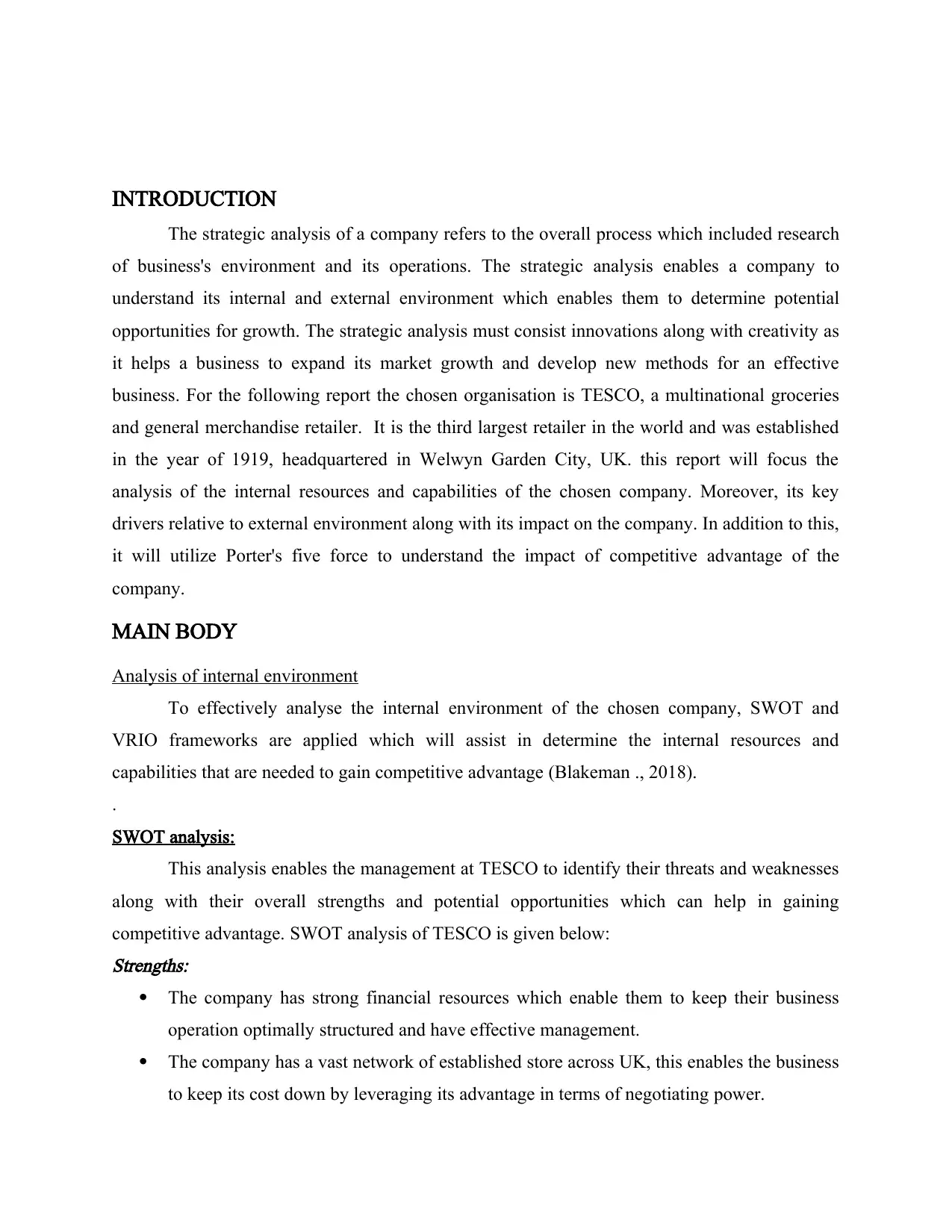
INTRODUCTION
The strategic analysis of a company refers to the overall process which included research
of business's environment and its operations. The strategic analysis enables a company to
understand its internal and external environment which enables them to determine potential
opportunities for growth. The strategic analysis must consist innovations along with creativity as
it helps a business to expand its market growth and develop new methods for an effective
business. For the following report the chosen organisation is TESCO, a multinational groceries
and general merchandise retailer. It is the third largest retailer in the world and was established
in the year of 1919, headquartered in Welwyn Garden City, UK. this report will focus the
analysis of the internal resources and capabilities of the chosen company. Moreover, its key
drivers relative to external environment along with its impact on the company. In addition to this,
it will utilize Porter's five force to understand the impact of competitive advantage of the
company.
MAIN BODY
Analysis of internal environment
To effectively analyse the internal environment of the chosen company, SWOT and
VRIO frameworks are applied which will assist in determine the internal resources and
capabilities that are needed to gain competitive advantage (Blakeman ., 2018).
.
SWOT analysis:
This analysis enables the management at TESCO to identify their threats and weaknesses
along with their overall strengths and potential opportunities which can help in gaining
competitive advantage. SWOT analysis of TESCO is given below:Strengths:
The company has strong financial resources which enable them to keep their business
operation optimally structured and have effective management.
The company has a vast network of established store across UK, this enables the business
to keep its cost down by leveraging its advantage in terms of negotiating power.
The strategic analysis of a company refers to the overall process which included research
of business's environment and its operations. The strategic analysis enables a company to
understand its internal and external environment which enables them to determine potential
opportunities for growth. The strategic analysis must consist innovations along with creativity as
it helps a business to expand its market growth and develop new methods for an effective
business. For the following report the chosen organisation is TESCO, a multinational groceries
and general merchandise retailer. It is the third largest retailer in the world and was established
in the year of 1919, headquartered in Welwyn Garden City, UK. this report will focus the
analysis of the internal resources and capabilities of the chosen company. Moreover, its key
drivers relative to external environment along with its impact on the company. In addition to this,
it will utilize Porter's five force to understand the impact of competitive advantage of the
company.
MAIN BODY
Analysis of internal environment
To effectively analyse the internal environment of the chosen company, SWOT and
VRIO frameworks are applied which will assist in determine the internal resources and
capabilities that are needed to gain competitive advantage (Blakeman ., 2018).
.
SWOT analysis:
This analysis enables the management at TESCO to identify their threats and weaknesses
along with their overall strengths and potential opportunities which can help in gaining
competitive advantage. SWOT analysis of TESCO is given below:Strengths:
The company has strong financial resources which enable them to keep their business
operation optimally structured and have effective management.
The company has a vast network of established store across UK, this enables the business
to keep its cost down by leveraging its advantage in terms of negotiating power.
⊘ This is a preview!⊘
Do you want full access?
Subscribe today to unlock all pages.

Trusted by 1+ million students worldwide
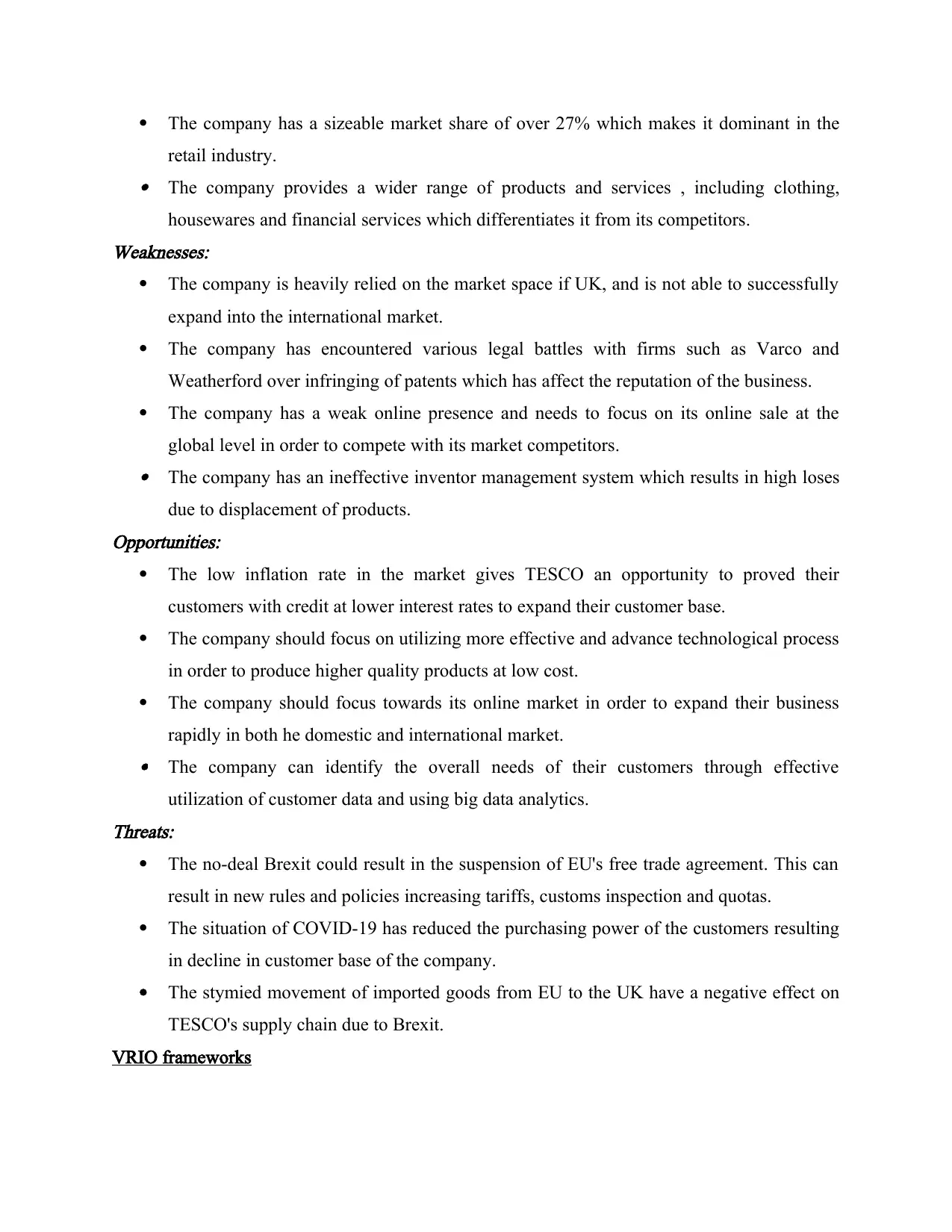
The company has a sizeable market share of over 27% which makes it dominant in the
retail industry. The company provides a wider range of products and services , including clothing,
housewares and financial services which differentiates it from its competitors.Weaknesses:
The company is heavily relied on the market space if UK, and is not able to successfully
expand into the international market.
The company has encountered various legal battles with firms such as Varco and
Weatherford over infringing of patents which has affect the reputation of the business.
The company has a weak online presence and needs to focus on its online sale at the
global level in order to compete with its market competitors. The company has an ineffective inventor management system which results in high loses
due to displacement of products.Opportunities:
The low inflation rate in the market gives TESCO an opportunity to proved their
customers with credit at lower interest rates to expand their customer base.
The company should focus on utilizing more effective and advance technological process
in order to produce higher quality products at low cost.
The company should focus towards its online market in order to expand their business
rapidly in both he domestic and international market. The company can identify the overall needs of their customers through effective
utilization of customer data and using big data analytics.Threats:
The no-deal Brexit could result in the suspension of EU's free trade agreement. This can
result in new rules and policies increasing tariffs, customs inspection and quotas.
The situation of COVID-19 has reduced the purchasing power of the customers resulting
in decline in customer base of the company.
The stymied movement of imported goods from EU to the UK have a negative effect on
TESCO's supply chain due to Brexit.
VRIO frameworks
retail industry. The company provides a wider range of products and services , including clothing,
housewares and financial services which differentiates it from its competitors.Weaknesses:
The company is heavily relied on the market space if UK, and is not able to successfully
expand into the international market.
The company has encountered various legal battles with firms such as Varco and
Weatherford over infringing of patents which has affect the reputation of the business.
The company has a weak online presence and needs to focus on its online sale at the
global level in order to compete with its market competitors. The company has an ineffective inventor management system which results in high loses
due to displacement of products.Opportunities:
The low inflation rate in the market gives TESCO an opportunity to proved their
customers with credit at lower interest rates to expand their customer base.
The company should focus on utilizing more effective and advance technological process
in order to produce higher quality products at low cost.
The company should focus towards its online market in order to expand their business
rapidly in both he domestic and international market. The company can identify the overall needs of their customers through effective
utilization of customer data and using big data analytics.Threats:
The no-deal Brexit could result in the suspension of EU's free trade agreement. This can
result in new rules and policies increasing tariffs, customs inspection and quotas.
The situation of COVID-19 has reduced the purchasing power of the customers resulting
in decline in customer base of the company.
The stymied movement of imported goods from EU to the UK have a negative effect on
TESCO's supply chain due to Brexit.
VRIO frameworks
Paraphrase This Document
Need a fresh take? Get an instant paraphrase of this document with our AI Paraphraser
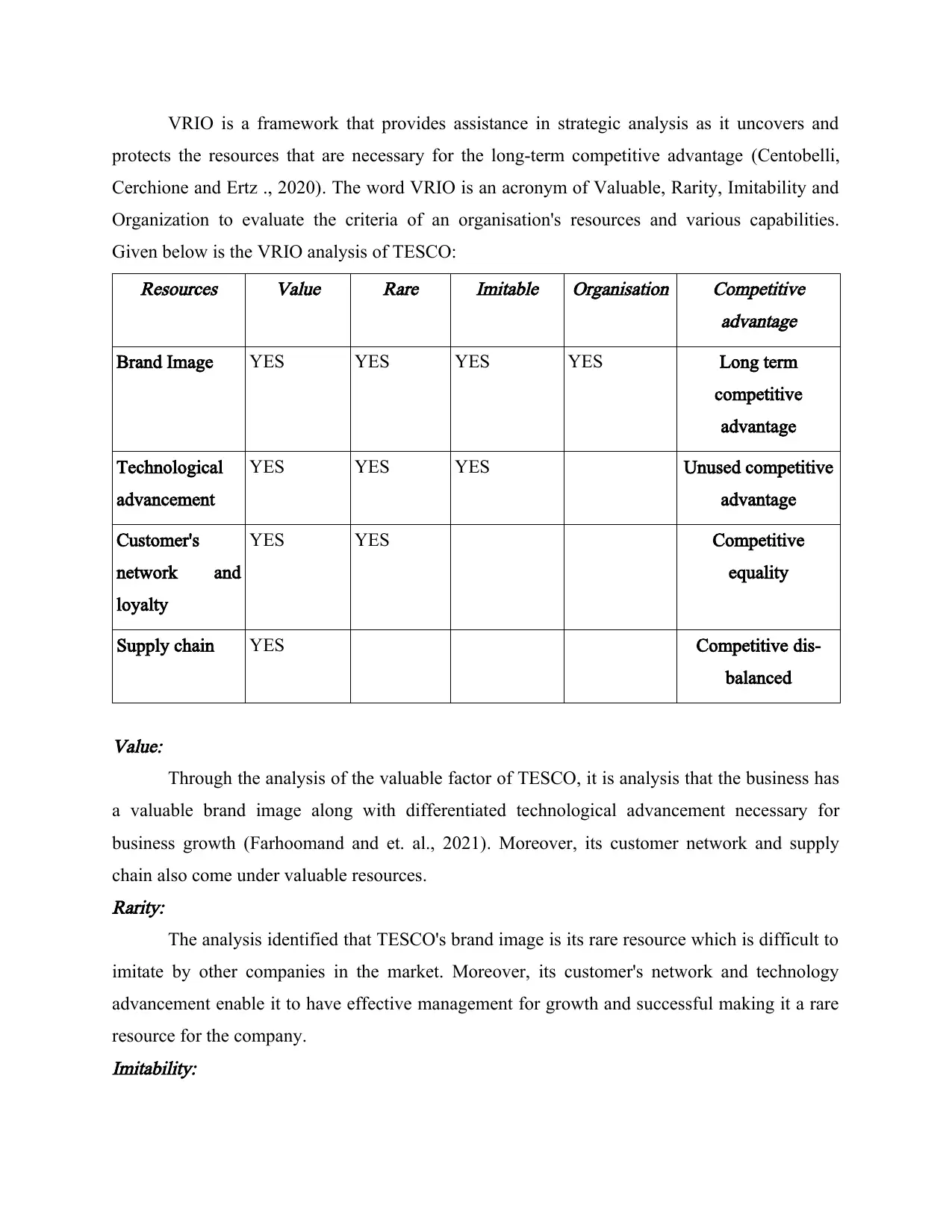
VRIO is a framework that provides assistance in strategic analysis as it uncovers and
protects the resources that are necessary for the long-term competitive advantage (Centobelli,
Cerchione and Ertz ., 2020). The word VRIO is an acronym of Valuable, Rarity, Imitability and
Organization to evaluate the criteria of an organisation's resources and various capabilities.
Given below is the VRIO analysis of TESCO:Resources Value Rare Imitable Organisation Competitive
advantage
Brand Image YES YES YES YES Long term
competitive
advantage
Technological
advancement
YES YES YES Unused competitive
advantage
Customer's
network and
loyalty
YES YES Competitive
equality
Supply chain YES Competitive dis-
balanced
Value:
Through the analysis of the valuable factor of TESCO, it is analysis that the business has
a valuable brand image along with differentiated technological advancement necessary for
business growth (Farhoomand and et. al., 2021). Moreover, its customer network and supply
chain also come under valuable resources.Rarity:
The analysis identified that TESCO's brand image is its rare resource which is difficult to
imitate by other companies in the market. Moreover, its customer's network and technology
advancement enable it to have effective management for growth and successful making it a rare
resource for the company.Imitability:
protects the resources that are necessary for the long-term competitive advantage (Centobelli,
Cerchione and Ertz ., 2020). The word VRIO is an acronym of Valuable, Rarity, Imitability and
Organization to evaluate the criteria of an organisation's resources and various capabilities.
Given below is the VRIO analysis of TESCO:Resources Value Rare Imitable Organisation Competitive
advantage
Brand Image YES YES YES YES Long term
competitive
advantage
Technological
advancement
YES YES YES Unused competitive
advantage
Customer's
network and
loyalty
YES YES Competitive
equality
Supply chain YES Competitive dis-
balanced
Value:
Through the analysis of the valuable factor of TESCO, it is analysis that the business has
a valuable brand image along with differentiated technological advancement necessary for
business growth (Farhoomand and et. al., 2021). Moreover, its customer network and supply
chain also come under valuable resources.Rarity:
The analysis identified that TESCO's brand image is its rare resource which is difficult to
imitate by other companies in the market. Moreover, its customer's network and technology
advancement enable it to have effective management for growth and successful making it a rare
resource for the company.Imitability:
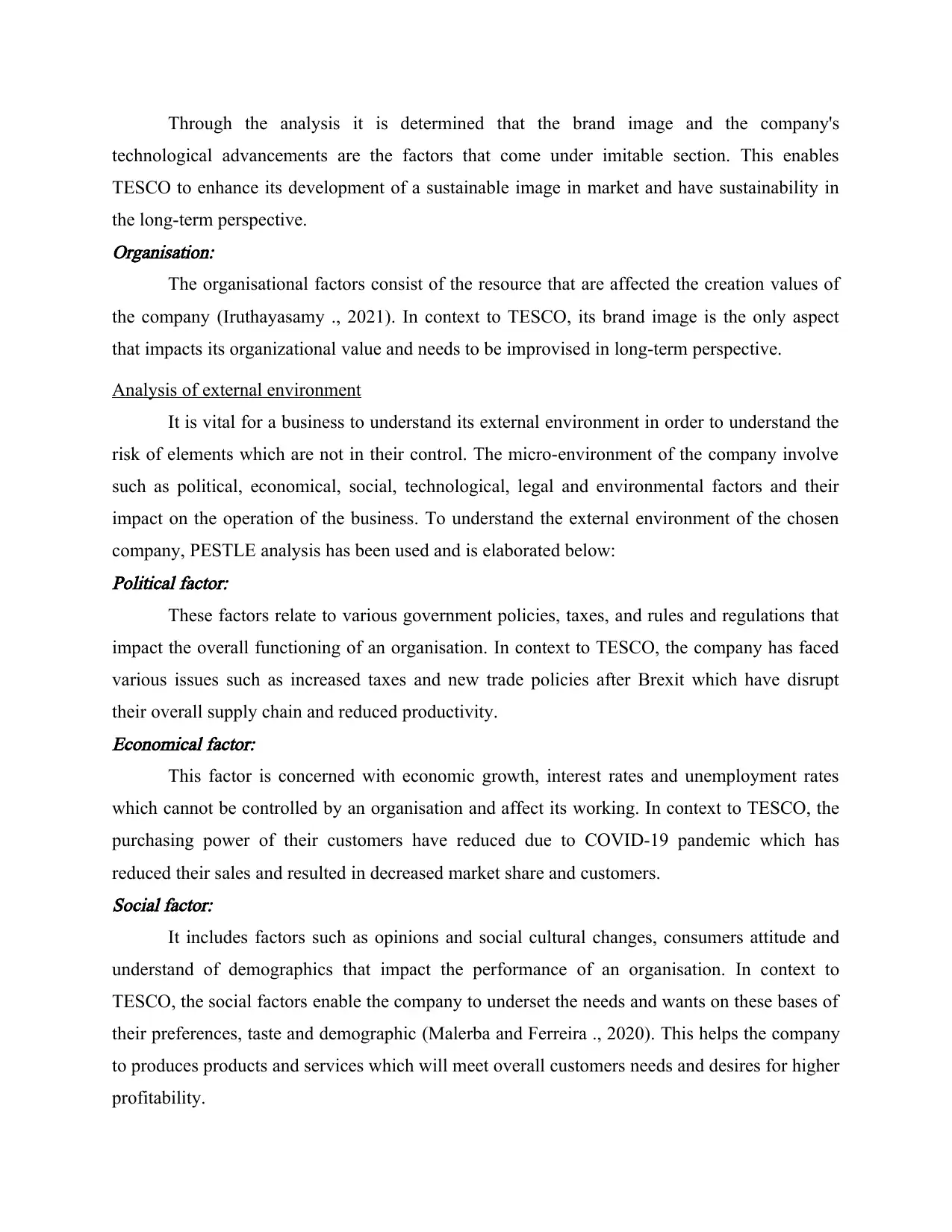
Through the analysis it is determined that the brand image and the company's
technological advancements are the factors that come under imitable section. This enables
TESCO to enhance its development of a sustainable image in market and have sustainability in
the long-term perspective.Organisation:
The organisational factors consist of the resource that are affected the creation values of
the company (Iruthayasamy ., 2021). In context to TESCO, its brand image is the only aspect
that impacts its organizational value and needs to be improvised in long-term perspective.
Analysis of external environment
It is vital for a business to understand its external environment in order to understand the
risk of elements which are not in their control. The micro-environment of the company involve
such as political, economical, social, technological, legal and environmental factors and their
impact on the operation of the business. To understand the external environment of the chosen
company, PESTLE analysis has been used and is elaborated below:Political factor:
These factors relate to various government policies, taxes, and rules and regulations that
impact the overall functioning of an organisation. In context to TESCO, the company has faced
various issues such as increased taxes and new trade policies after Brexit which have disrupt
their overall supply chain and reduced productivity.Economical factor:
This factor is concerned with economic growth, interest rates and unemployment rates
which cannot be controlled by an organisation and affect its working. In context to TESCO, the
purchasing power of their customers have reduced due to COVID-19 pandemic which has
reduced their sales and resulted in decreased market share and customers.Social factor:
It includes factors such as opinions and social cultural changes, consumers attitude and
understand of demographics that impact the performance of an organisation. In context to
TESCO, the social factors enable the company to underset the needs and wants on these bases of
their preferences, taste and demographic (Malerba and Ferreira ., 2020). This helps the company
to produces products and services which will meet overall customers needs and desires for higher
profitability.
technological advancements are the factors that come under imitable section. This enables
TESCO to enhance its development of a sustainable image in market and have sustainability in
the long-term perspective.Organisation:
The organisational factors consist of the resource that are affected the creation values of
the company (Iruthayasamy ., 2021). In context to TESCO, its brand image is the only aspect
that impacts its organizational value and needs to be improvised in long-term perspective.
Analysis of external environment
It is vital for a business to understand its external environment in order to understand the
risk of elements which are not in their control. The micro-environment of the company involve
such as political, economical, social, technological, legal and environmental factors and their
impact on the operation of the business. To understand the external environment of the chosen
company, PESTLE analysis has been used and is elaborated below:Political factor:
These factors relate to various government policies, taxes, and rules and regulations that
impact the overall functioning of an organisation. In context to TESCO, the company has faced
various issues such as increased taxes and new trade policies after Brexit which have disrupt
their overall supply chain and reduced productivity.Economical factor:
This factor is concerned with economic growth, interest rates and unemployment rates
which cannot be controlled by an organisation and affect its working. In context to TESCO, the
purchasing power of their customers have reduced due to COVID-19 pandemic which has
reduced their sales and resulted in decreased market share and customers.Social factor:
It includes factors such as opinions and social cultural changes, consumers attitude and
understand of demographics that impact the performance of an organisation. In context to
TESCO, the social factors enable the company to underset the needs and wants on these bases of
their preferences, taste and demographic (Malerba and Ferreira ., 2020). This helps the company
to produces products and services which will meet overall customers needs and desires for higher
profitability.
⊘ This is a preview!⊘
Do you want full access?
Subscribe today to unlock all pages.

Trusted by 1+ million students worldwide
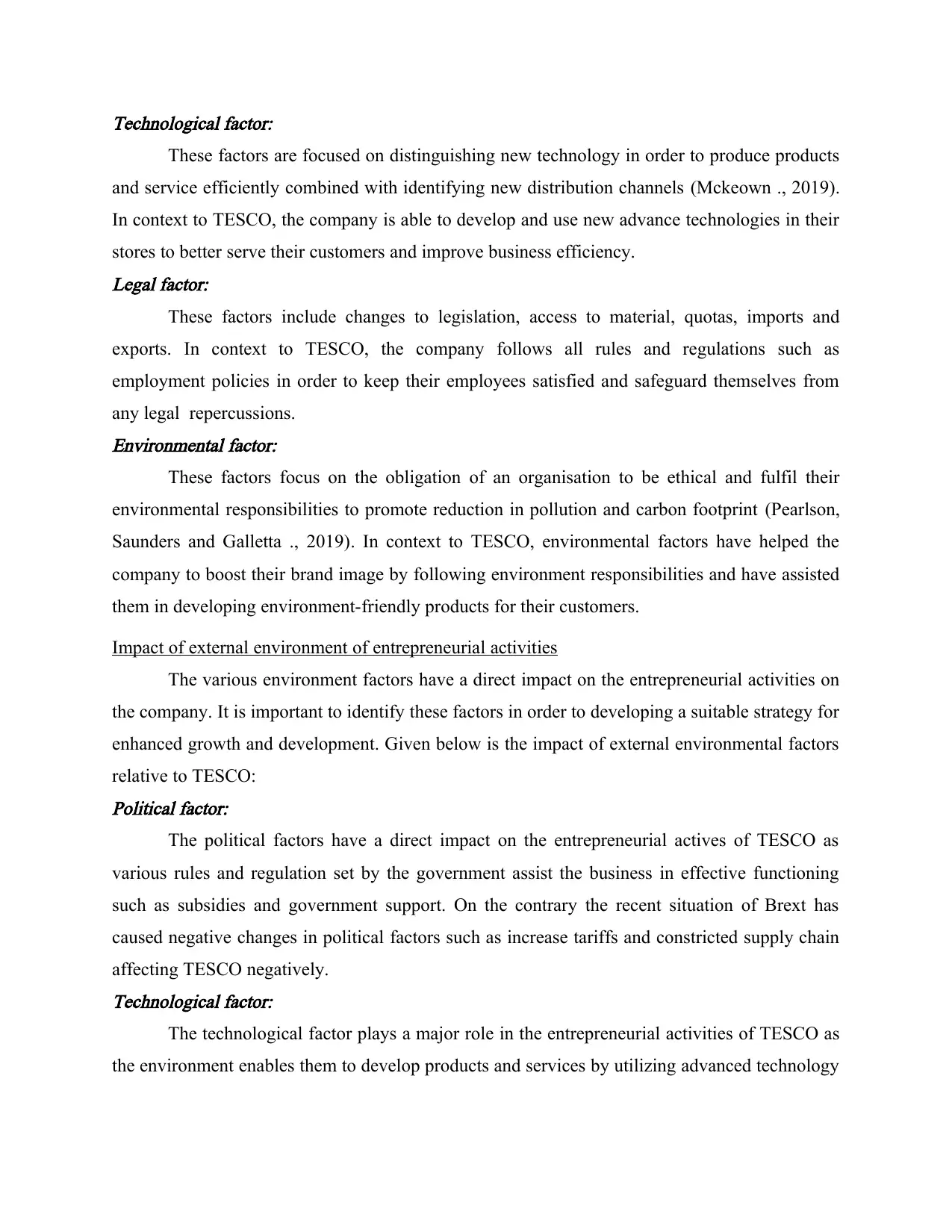
Technological factor:
These factors are focused on distinguishing new technology in order to produce products
and service efficiently combined with identifying new distribution channels (Mckeown ., 2019).
In context to TESCO, the company is able to develop and use new advance technologies in their
stores to better serve their customers and improve business efficiency.Legal factor:
These factors include changes to legislation, access to material, quotas, imports and
exports. In context to TESCO, the company follows all rules and regulations such as
employment policies in order to keep their employees satisfied and safeguard themselves from
any legal repercussions.Environmental factor:
These factors focus on the obligation of an organisation to be ethical and fulfil their
environmental responsibilities to promote reduction in pollution and carbon footprint (Pearlson,
Saunders and Galletta ., 2019). In context to TESCO, environmental factors have helped the
company to boost their brand image by following environment responsibilities and have assisted
them in developing environment-friendly products for their customers.
Impact of external environment of entrepreneurial activities
The various environment factors have a direct impact on the entrepreneurial activities on
the company. It is important to identify these factors in order to developing a suitable strategy for
enhanced growth and development. Given below is the impact of external environmental factors
relative to TESCO:Political factor:
The political factors have a direct impact on the entrepreneurial actives of TESCO as
various rules and regulation set by the government assist the business in effective functioning
such as subsidies and government support. On the contrary the recent situation of Brext has
caused negative changes in political factors such as increase tariffs and constricted supply chain
affecting TESCO negatively.Technological factor:
The technological factor plays a major role in the entrepreneurial activities of TESCO as
the environment enables them to develop products and services by utilizing advanced technology
These factors are focused on distinguishing new technology in order to produce products
and service efficiently combined with identifying new distribution channels (Mckeown ., 2019).
In context to TESCO, the company is able to develop and use new advance technologies in their
stores to better serve their customers and improve business efficiency.Legal factor:
These factors include changes to legislation, access to material, quotas, imports and
exports. In context to TESCO, the company follows all rules and regulations such as
employment policies in order to keep their employees satisfied and safeguard themselves from
any legal repercussions.Environmental factor:
These factors focus on the obligation of an organisation to be ethical and fulfil their
environmental responsibilities to promote reduction in pollution and carbon footprint (Pearlson,
Saunders and Galletta ., 2019). In context to TESCO, environmental factors have helped the
company to boost their brand image by following environment responsibilities and have assisted
them in developing environment-friendly products for their customers.
Impact of external environment of entrepreneurial activities
The various environment factors have a direct impact on the entrepreneurial activities on
the company. It is important to identify these factors in order to developing a suitable strategy for
enhanced growth and development. Given below is the impact of external environmental factors
relative to TESCO:Political factor:
The political factors have a direct impact on the entrepreneurial actives of TESCO as
various rules and regulation set by the government assist the business in effective functioning
such as subsidies and government support. On the contrary the recent situation of Brext has
caused negative changes in political factors such as increase tariffs and constricted supply chain
affecting TESCO negatively.Technological factor:
The technological factor plays a major role in the entrepreneurial activities of TESCO as
the environment enables them to develop products and services by utilizing advanced technology
Paraphrase This Document
Need a fresh take? Get an instant paraphrase of this document with our AI Paraphraser
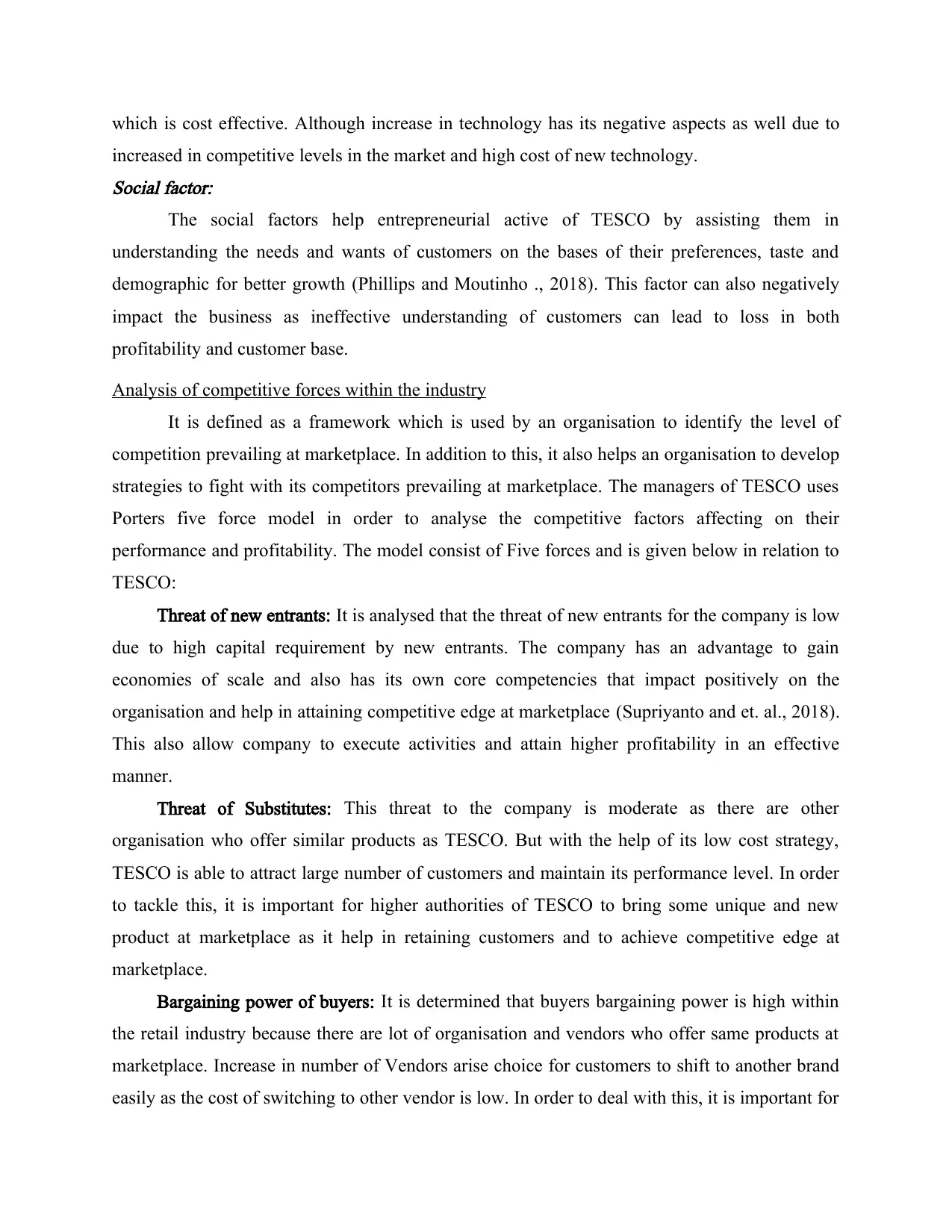
which is cost effective. Although increase in technology has its negative aspects as well due to
increased in competitive levels in the market and high cost of new technology.Social factor:
The social factors help entrepreneurial active of TESCO by assisting them in
understanding the needs and wants of customers on the bases of their preferences, taste and
demographic for better growth (Phillips and Moutinho ., 2018). This factor can also negatively
impact the business as ineffective understanding of customers can lead to loss in both
profitability and customer base.
Analysis of competitive forces within the industry
It is defined as a framework which is used by an organisation to identify the level of
competition prevailing at marketplace. In addition to this, it also helps an organisation to develop
strategies to fight with its competitors prevailing at marketplace. The managers of TESCO uses
Porters five force model in order to analyse the competitive factors affecting on their
performance and profitability. The model consist of Five forces and is given below in relation to
TESCO:
Threat of new entrants: It is analysed that the threat of new entrants for the company is low
due to high capital requirement by new entrants. The company has an advantage to gain
economies of scale and also has its own core competencies that impact positively on the
organisation and help in attaining competitive edge at marketplace (Supriyanto and et. al., 2018).
This also allow company to execute activities and attain higher profitability in an effective
manner.
Threat of Substitutes: This threat to the company is moderate as there are other
organisation who offer similar products as TESCO. But with the help of its low cost strategy,
TESCO is able to attract large number of customers and maintain its performance level. In order
to tackle this, it is important for higher authorities of TESCO to bring some unique and new
product at marketplace as it help in retaining customers and to achieve competitive edge at
marketplace.
Bargaining power of buyers: It is determined that buyers bargaining power is high within
the retail industry because there are lot of organisation and vendors who offer same products at
marketplace. Increase in number of Vendors arise choice for customers to shift to another brand
easily as the cost of switching to other vendor is low. In order to deal with this, it is important for
increased in competitive levels in the market and high cost of new technology.Social factor:
The social factors help entrepreneurial active of TESCO by assisting them in
understanding the needs and wants of customers on the bases of their preferences, taste and
demographic for better growth (Phillips and Moutinho ., 2018). This factor can also negatively
impact the business as ineffective understanding of customers can lead to loss in both
profitability and customer base.
Analysis of competitive forces within the industry
It is defined as a framework which is used by an organisation to identify the level of
competition prevailing at marketplace. In addition to this, it also helps an organisation to develop
strategies to fight with its competitors prevailing at marketplace. The managers of TESCO uses
Porters five force model in order to analyse the competitive factors affecting on their
performance and profitability. The model consist of Five forces and is given below in relation to
TESCO:
Threat of new entrants: It is analysed that the threat of new entrants for the company is low
due to high capital requirement by new entrants. The company has an advantage to gain
economies of scale and also has its own core competencies that impact positively on the
organisation and help in attaining competitive edge at marketplace (Supriyanto and et. al., 2018).
This also allow company to execute activities and attain higher profitability in an effective
manner.
Threat of Substitutes: This threat to the company is moderate as there are other
organisation who offer similar products as TESCO. But with the help of its low cost strategy,
TESCO is able to attract large number of customers and maintain its performance level. In order
to tackle this, it is important for higher authorities of TESCO to bring some unique and new
product at marketplace as it help in retaining customers and to achieve competitive edge at
marketplace.
Bargaining power of buyers: It is determined that buyers bargaining power is high within
the retail industry because there are lot of organisation and vendors who offer same products at
marketplace. Increase in number of Vendors arise choice for customers to shift to another brand
easily as the cost of switching to other vendor is low. In order to deal with this, it is important for
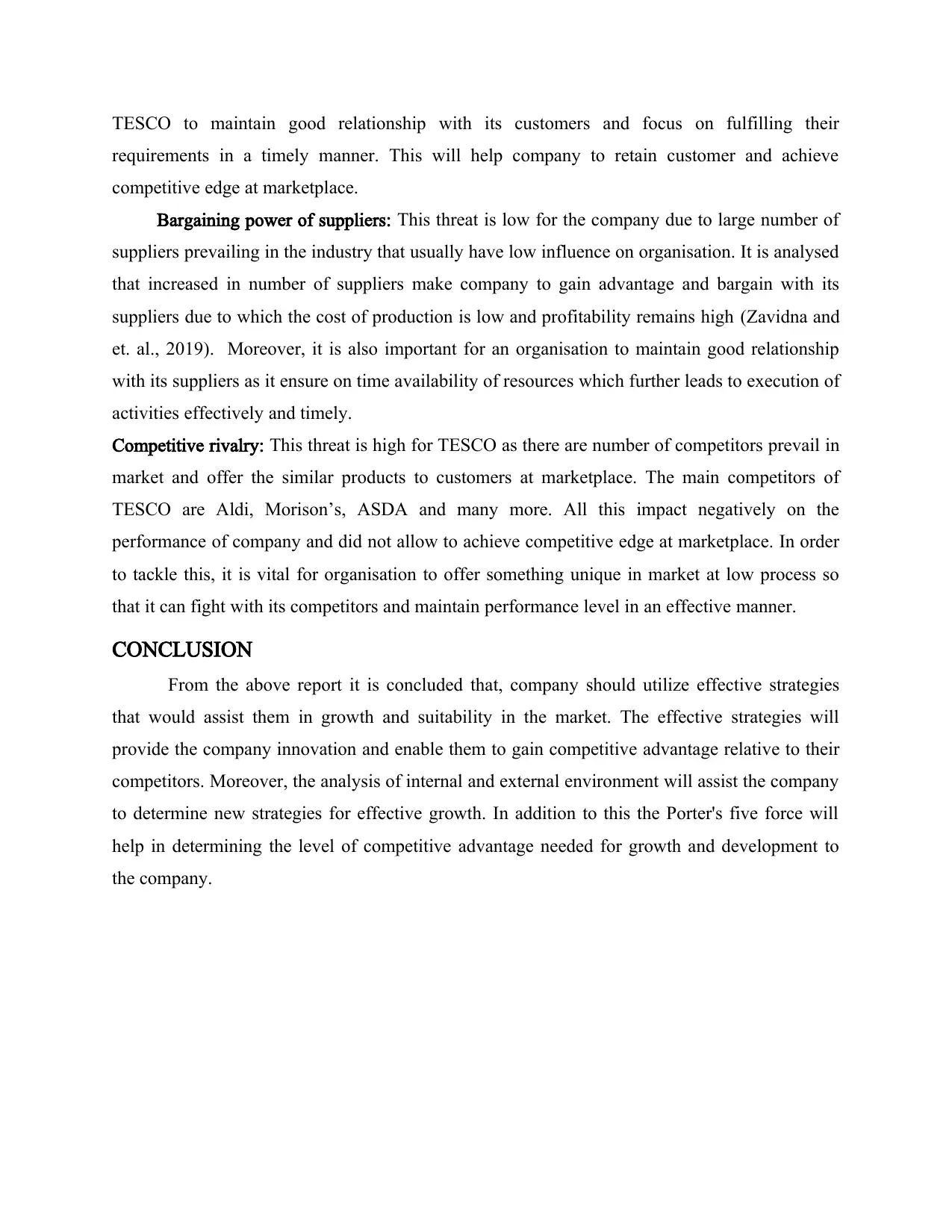
TESCO to maintain good relationship with its customers and focus on fulfilling their
requirements in a timely manner. This will help company to retain customer and achieve
competitive edge at marketplace.
Bargaining power of suppliers: This threat is low for the company due to large number of
suppliers prevailing in the industry that usually have low influence on organisation. It is analysed
that increased in number of suppliers make company to gain advantage and bargain with its
suppliers due to which the cost of production is low and profitability remains high (Zavidna and
et. al., 2019). Moreover, it is also important for an organisation to maintain good relationship
with its suppliers as it ensure on time availability of resources which further leads to execution of
activities effectively and timely.
Competitive rivalry: This threat is high for TESCO as there are number of competitors prevail in
market and offer the similar products to customers at marketplace. The main competitors of
TESCO are Aldi, Morison’s, ASDA and many more. All this impact negatively on the
performance of company and did not allow to achieve competitive edge at marketplace. In order
to tackle this, it is vital for organisation to offer something unique in market at low process so
that it can fight with its competitors and maintain performance level in an effective manner.
CONCLUSION
From the above report it is concluded that, company should utilize effective strategies
that would assist them in growth and suitability in the market. The effective strategies will
provide the company innovation and enable them to gain competitive advantage relative to their
competitors. Moreover, the analysis of internal and external environment will assist the company
to determine new strategies for effective growth. In addition to this the Porter's five force will
help in determining the level of competitive advantage needed for growth and development to
the company.
requirements in a timely manner. This will help company to retain customer and achieve
competitive edge at marketplace.
Bargaining power of suppliers: This threat is low for the company due to large number of
suppliers prevailing in the industry that usually have low influence on organisation. It is analysed
that increased in number of suppliers make company to gain advantage and bargain with its
suppliers due to which the cost of production is low and profitability remains high (Zavidna and
et. al., 2019). Moreover, it is also important for an organisation to maintain good relationship
with its suppliers as it ensure on time availability of resources which further leads to execution of
activities effectively and timely.
Competitive rivalry: This threat is high for TESCO as there are number of competitors prevail in
market and offer the similar products to customers at marketplace. The main competitors of
TESCO are Aldi, Morison’s, ASDA and many more. All this impact negatively on the
performance of company and did not allow to achieve competitive edge at marketplace. In order
to tackle this, it is vital for organisation to offer something unique in market at low process so
that it can fight with its competitors and maintain performance level in an effective manner.
CONCLUSION
From the above report it is concluded that, company should utilize effective strategies
that would assist them in growth and suitability in the market. The effective strategies will
provide the company innovation and enable them to gain competitive advantage relative to their
competitors. Moreover, the analysis of internal and external environment will assist the company
to determine new strategies for effective growth. In addition to this the Porter's five force will
help in determining the level of competitive advantage needed for growth and development to
the company.
⊘ This is a preview!⊘
Do you want full access?
Subscribe today to unlock all pages.

Trusted by 1+ million students worldwide
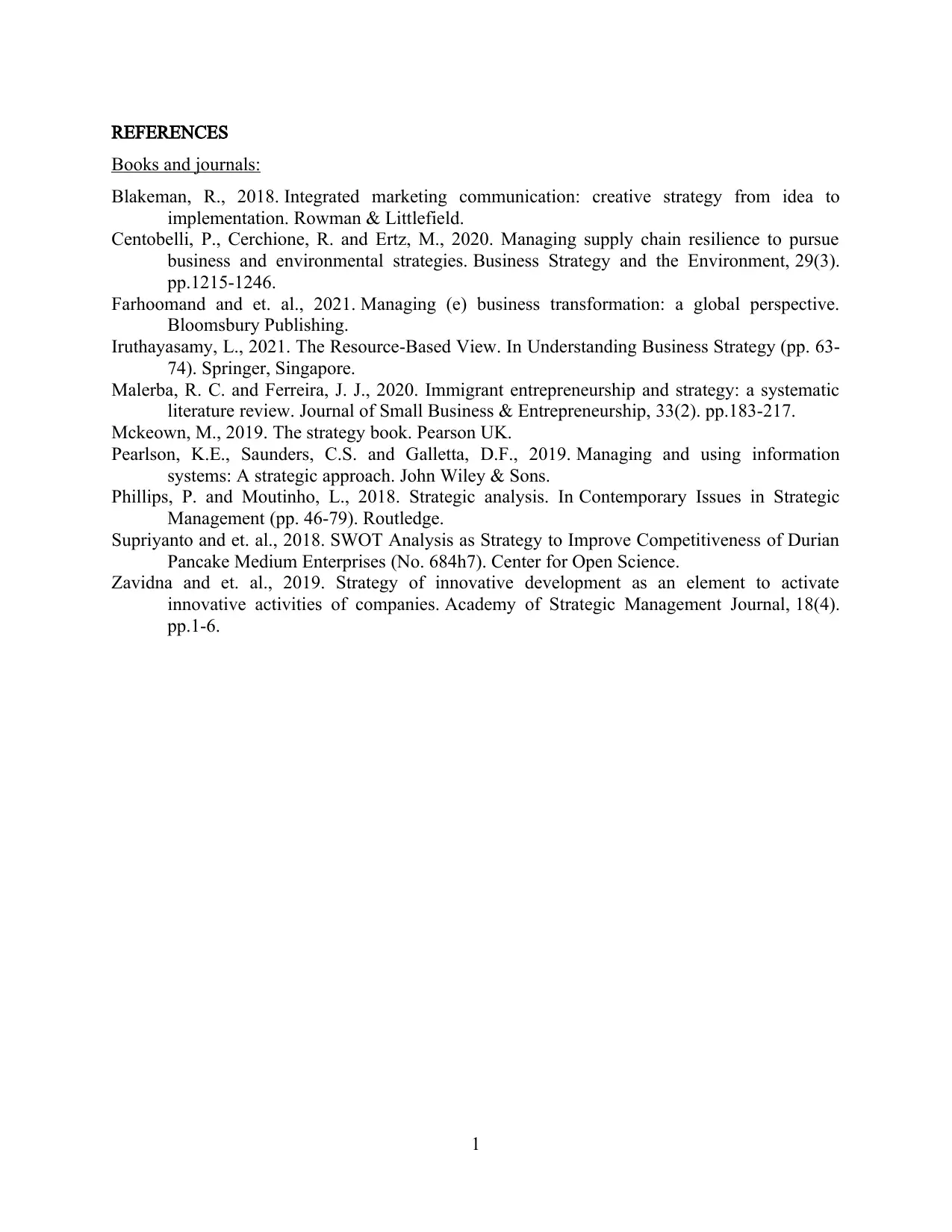
REFERENCES
Books and journals:
Blakeman, R., 2018. Integrated marketing communication: creative strategy from idea to
implementation. Rowman & Littlefield.
Centobelli, P., Cerchione, R. and Ertz, M., 2020. Managing supply chain resilience to pursue
business and environmental strategies. Business Strategy and the Environment, 29(3).
pp.1215-1246.
Farhoomand and et. al., 2021. Managing (e) business transformation: a global perspective.
Bloomsbury Publishing.
Iruthayasamy, L., 2021. The Resource-Based View. In Understanding Business Strategy (pp. 63-
74). Springer, Singapore.
Malerba, R. C. and Ferreira, J. J., 2020. Immigrant entrepreneurship and strategy: a systematic
literature review. Journal of Small Business & Entrepreneurship, 33(2). pp.183-217.
Mckeown, M., 2019. The strategy book. Pearson UK.
Pearlson, K.E., Saunders, C.S. and Galletta, D.F., 2019. Managing and using information
systems: A strategic approach. John Wiley & Sons.
Phillips, P. and Moutinho, L., 2018. Strategic analysis. In Contemporary Issues in Strategic
Management (pp. 46-79). Routledge.
Supriyanto and et. al., 2018. SWOT Analysis as Strategy to Improve Competitiveness of Durian
Pancake Medium Enterprises (No. 684h7). Center for Open Science.
Zavidna and et. al., 2019. Strategy of innovative development as an element to activate
innovative activities of companies. Academy of Strategic Management Journal, 18(4).
pp.1-6.
1
Books and journals:
Blakeman, R., 2018. Integrated marketing communication: creative strategy from idea to
implementation. Rowman & Littlefield.
Centobelli, P., Cerchione, R. and Ertz, M., 2020. Managing supply chain resilience to pursue
business and environmental strategies. Business Strategy and the Environment, 29(3).
pp.1215-1246.
Farhoomand and et. al., 2021. Managing (e) business transformation: a global perspective.
Bloomsbury Publishing.
Iruthayasamy, L., 2021. The Resource-Based View. In Understanding Business Strategy (pp. 63-
74). Springer, Singapore.
Malerba, R. C. and Ferreira, J. J., 2020. Immigrant entrepreneurship and strategy: a systematic
literature review. Journal of Small Business & Entrepreneurship, 33(2). pp.183-217.
Mckeown, M., 2019. The strategy book. Pearson UK.
Pearlson, K.E., Saunders, C.S. and Galletta, D.F., 2019. Managing and using information
systems: A strategic approach. John Wiley & Sons.
Phillips, P. and Moutinho, L., 2018. Strategic analysis. In Contemporary Issues in Strategic
Management (pp. 46-79). Routledge.
Supriyanto and et. al., 2018. SWOT Analysis as Strategy to Improve Competitiveness of Durian
Pancake Medium Enterprises (No. 684h7). Center for Open Science.
Zavidna and et. al., 2019. Strategy of innovative development as an element to activate
innovative activities of companies. Academy of Strategic Management Journal, 18(4).
pp.1-6.
1
1 out of 10
Related Documents
Your All-in-One AI-Powered Toolkit for Academic Success.
+13062052269
info@desklib.com
Available 24*7 on WhatsApp / Email
![[object Object]](/_next/static/media/star-bottom.7253800d.svg)
Unlock your academic potential
Copyright © 2020–2025 A2Z Services. All Rights Reserved. Developed and managed by ZUCOL.





